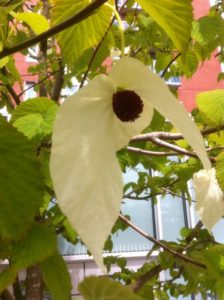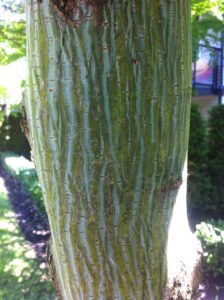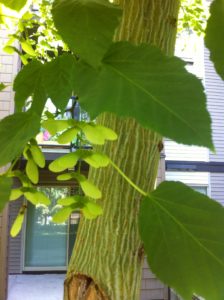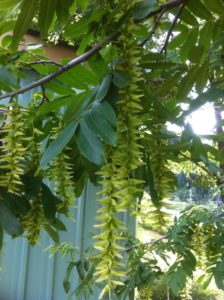Our Lower Mainland multi-family (strata) complexes tend to get planted with the same plants. Over and over. It makes sense since our soils are mostly acidic.
The plant repetition is boring but it also works in our favour when we try to learn plant names. Once you learn the key species you should be in great shape on your other sites. Repetition.
This blog post shows some of the uncommon strata trees. They stand out because they surprised me by their presence or by the fact that I had to snap pictures and look them up. I make it my goal to know every plant on my work sites. It helps with maintenance work, client requests and employee training.
Davidia involucrata (Ghost tree)

I first encountered this tree was at an up-stairs daycare in Vancouver. The tree was growing in a raised cement circle so you had to look up into it. Bang. There were white ghosts all over. I keyed out the tree the same night.
The two long white bracts look like ghosts. It’s an awesome vision. I have since discovered other specimens in the Poirier complex in Coquitlam. You don’t see these trees much. I think we should.
Note, this tree is a poster child for learning botanical names. You just have to learn one. One. As for common names, there are many. Four to six. That sounds like a lot of work. Davidia involucrata is all you need.
Acer davidii (Snake bark maple)


This is another gem. I only have it on one site in Burnaby. The bark is gorgeous. It does remind you of snakes. Snake bark maple. I had to key this one out at home and now it’s nicely stuck in my head. I hope you are lucky enough to see one.
Pterocarya stenoptera (Chinese wingnut tree)

Again, I only know one specimen. It’s located by the Coquitlam animal shelter. The long strings of winged seeds are striking. I had no idea what tree this was. So I did some homework at home.
Note, if the Ghost tree above is a poster child for learning botanical names, this one is a poster child for the difficulty of remembering them. Pterocarya stenoptera takes some practice. I openly admit it.
I hope you will get some nice plant surprises as you move through new gardens and landscapes. It’s exciting!


